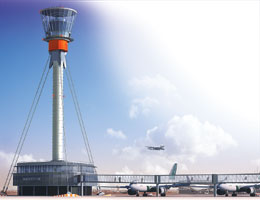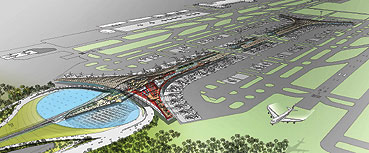 |
Globally, airport investment is "by and large picking up," says Gilles Hondius, director of The Hague-based Netherlands Airport Consultants B.V (NACO), which has focused solely on airport planning and design for more than 50 years. In Europe, former Communist countries are increasing airport spending as their economies improve, says Hondius. "A lot of airports are in urgent need of refurbishment if not replacement," he says. Throughout the Middle East, "there is work to be done."
Most airport growth will occur in Asia, especially India and China, says Rudolf Burkhalter, master planning director for Germanys Hochtief AirPort GmbH, Essen, a firm created in the 1990s to develop and buy into airports.
|
NO FRILLS
Southeast Asia and Europe have little potential for large greenfield developments, says Martin Manning, airports director at London-based design firm Arup Group Ltd. However, "theres going to be huge growth in smaller airports. The whole low-cost airline fleet mix is changing quite a lot."
Low-cost, no-frills airlines "have brought new traffic to places where there was no traffic before, and thats keeping us quite busy," says Hondius. Originating in the Irish Republic and the U.K., budget air travel is spreading to the Middle East and Asia, he notes. While this trend is nurturing expansion at smaller airports, it is creating conflicting demands for bigger operators. "We will have a product for the big airline alliances and...a product for low-cost carriers, with no transfers and very few services," says Burkhalter. "Its quite a challenge for the airports, especially if you have invested in huge facilities in the last decade."
 |
| POISED TO FLY Londons $6.6-billion airport expansion is well under way. |
CHANGES AHEAD
Enhanced airport security is a factor for designers, but it is largely a question of increasing surveillance, a growing business, says Manning. European airports are already "quite well-protected" in security baggage screening as are the newer Asian airports, Hondius says.
The prospect of the Airbus A380 super-jumbo jet in 2006 is a bigger factor. "All the big hubs are reviewing their facilities to accommodate the A380," says Burkhalter. "You try to find intelligent solutions which limit the amount of construction." But the task is daunting. Londons Heathrow Airport is estimated to need over $650 million of remodeling for the A380 over the next decade.
Another shift in airport design stems from the growth of nonaviation revenue sources, says Hondius. Retail sales in terminals and nearby real estate developments are generating more business, thus augmenting aviation revenue. Growth in leisure travel is also boosting demand for retail business in airports.
 |
| LONDON CALLING Heathrow $6.6-billion program never stopped taxiing during downturn. |
But aside from meeting these commercial needs, airports are becoming more "industrial," with the terminal just one link in a transportation chain, notes Manning. "The terminal will no longer be a destination in itself," he predicts. Thus, "grand gesture" terminal designs are becoming less appropriate. Major changes are driven by computer technology advances, says Manning. "Our communications work is growing dramatically and things are getting more complex," he adds.
NACO worked to avoid complexity in planning of a new $2-billion terminal at Beijing, China. Foster and Partners, London, and Arup are also on the newly selected team. Their plan "seems so simple and logical you wonder why it was such an effort to conceive it," says Hondius. Designed for 35 million passengers a year, "its big, yet it aims to be as simple as possible in the sense of flow and movements."
Due to open in 2007, the new 500,000-sq-m terminal will more than double the airports capacity to 60 million passengers a year, a figure expected by 2015. It will have two three-winged buildings set nearly 1 km apart, linked by an underground people mover.
ASIA ACTIVE
Beiijing is Chinas flagship project, but many others are in development, says Burkhalter. A new $200-million terminal is under construction in Chongqing province. With an outline design by Arup and architect Llewelyn Davies Ltd., London, the terminals ultimate capacity will be 15 million passengers a year. Local industries will need management skills to make their facilities profitable, adds Burkhalter.
 |
| SIMPLE FUTURE Beijings $2-billion new terminal emphasizes simplicity and logistics for moving an expected 60 million passengers annually. (Photo courtesy of Foster and Partners) |
Running some of the "worst airports in the whole world," India has major needs for managing services, says Burkhalter. With financing scarce, India is looking for private-sector investment and considering privatizing the airports in Delhi and Mumbai. The idea has been around for a few years, and now "it seems to be getting more serious. But we still dont know," says Burkhalter.
Smaller projects in Bangalore and Hyderabad also are about to take off. For Hyderabad, growing fast on the back of information technology industries, an Indian/Malaysian joint venture is now negotiating with government agencies for the estimated $250-million build-operate-transfer contract, which could start sometime in 2004. Due for completion in 2007, the airport is being designed by a team led by Denmarks COWI A/S, Lyngby, which was appointed this year.
EUROPE EAGER
In Eastern Europe, almost all the smaller capitals are pursuing airport projects, says Burkhalter. One of Polands largest construction jobs is a $200-million new terminal contract that went last year to a consortium led by Madrid-based Ferrovial Agroman S.A., with Polish local subsidiary Budimex Group, and Madrid-based architect Lamela Estudio. The 100,000-sq-m terminal will be able to handle 12.5 million passengers a year.
In Prague, a division of Swedens Skanska A.B., Stockholm, in joint venture with Strabag A.G., Linz, Austria, last month won a $120-million contract for a 50,000-sq-m terminal at Ruzyne International Airport. The Czech Airports Authority is using European Investment Bank loans to help finance work, which is due to end in 2005.
At Moscows Sheremetyevo Airport, a third terminal project may soon start, says Stephen Raybould, commercial manager for London-based Bovis Lend Lease Ltd., which last year received the $520-million design-build contract from the Russian airline Aeroflot.
One of Europes largest airport developments is taking place at the worlds busiest international airport, Londons Heathrow. Owner BAA plc kept on planning the $6.6-billion development through the downturn. Rising traffic figures may vindicate the decision to push ahead with the fifth terminal and related facilities. With work about one-third complete, BAA says the job is ahead of schedule. In November, the company announced another $170-million investment to ensure a single opening in 2008 rather than phasing it over four years.
 |
| HAMBURG HAIL Terminal reconstruction is symbolic of steady European airport building. |
Germanys biggest planned airport project has yet to take off. Nearly 10 years after the government began planning a new, privately financed $2-billion airport at former East Berlins Schönefeld site, a contract has not been awarded. Negotiations with a consortium including Hochtief ended this year at an impasse. Expectations on scope could not be matched by forecast revenue, claim consortium members. Germany is now pushing ahead with permitting and planning work, hoping to start procurement again next year. In Hamburg, the airport plans a $475-million project including reconstruction of a second terminal.
In Western Europe, Spains civil aviation authority Aeropuertos Españoles y Navegacíon Aérea has begun work on a 470,000-sq-m terminal with 9,000 parking spaces at Madrid Barajas International Airport. Barcelonas airport is also expanding due to the doubling of its traffic to 20 million passengers a year since the 1992 Olympics.
One of the worlds biggest and most unusual terminal projects is now under construction in the United Arab Emirates. Architects from Frances Aéroports de Paris, with Lebanon-based structural engineer Dar Al-Handasah Shair and Partners, located the 300 x 350-m third terminal to 25 m below ground, to be covered with aprons and taxiways.
Work began with this Julys civil work contract held by the Anglo/Dubai Al Naboodah-Laing ORourke joint venture. The 30-month contract covers engineering, foundations and structural concrete, and calls for 2.4 million cu m of concrete to be cast. Costing $4.1 billion, according to Dubai Dept. of Civil Aviation, the project follows a previous expansion completed in 2000 for $540 million. This time, the owner is building in plenty of spare capacity. The airport handles over 20 million passengers a year, and expansion will triple that.
Because of security, "in Dubai both arriving and deplaning passengers are kept separate until they have gone through certain security checks," says G. William Doerge, principal of designer Perkins & Will. Because of this complicated circulation, "signage and graphicsproviding information to passengersis becoming a much more important aspect in the design process."
Click below for more articles from special report "Airports of the Future">>
Introduction: Challenges in Airport Design and Construction Aren't New
Design: The Future is At the Gate
Security: Baggage Screening Goes In-line, Out of View
Regionals: Reviving with Revisions
Connections: Take the Train to the Plane
Airport Products

Post a comment to this article
Report Abusive Comment